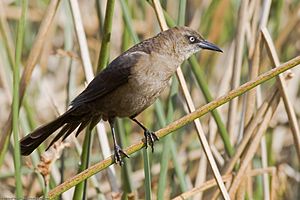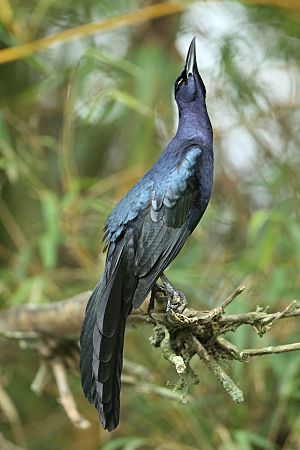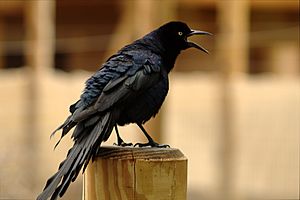Great-tailed grackle facts for kids
Quick facts for kids Great-tailed grackle |
|
|---|---|
 |
|
| Male perched on a branch | |
| Conservation status | |
| Scientific classification | |
| Genus: |
Quiscalus
|
| Species: |
mexicanus
|
 |
|
| Range of Quiscalus mexicanus | |
The great-tailed grackle or Mexican grackle (Quiscalus mexicanus) is a medium-sized bird. It is a very social passerine bird, meaning it's a type of perching bird. These birds live in North and South America.
The great-tailed grackle belongs to the family called Icteridae. It is one of 10 living types of grackle. It is closely related to the boat-tailed grackle. In the southern United States, people sometimes call it a "blackbird" or even a "crow." This is because of its shiny black feathers. In parts of Mexico, it's called cuervo ("crow"). But it's not actually a crow. It's not even in the crow family.
Contents
What Does a Great-Tailed Grackle Look Like?
Great-tailed grackles are medium-sized birds. They are bigger than starlings but smaller than crows. They are about 38 to 46 centimeters (15 to 18 inches) long. Males weigh between 203 and 265 grams (7.2 to 9.3 ounces). Females are lighter, weighing 115 to 142 grams (4.1 to 5.0 ounces). Both male and female grackles have long tails. Their wingspan is about 48 to 58 cm (18.9 to 22.8 inches).
Male grackles are shiny black. Their head and upper body feathers have a purple-blue shimmer. Female grackles are brown. Their wings and tail are a darker brown. Adult grackles, both male and female, have bright yellow eyes. Young grackles have brown eyes and brown feathers, much like the females. However, young birds have streaks on their chest. Male great-tailed grackles have a special tail. It is shaped like a boat's keel and they can fold it vertically.
For a long time, the great-tailed grackle and the boat-tailed grackle were thought to be the same species. But then, scientists studied their genes. They found out that these two are actually different species.
Grackle Sounds and Calls
Great-tailed grackles make many different sounds. They use these sounds all year long. Their calls can sound like "sweet, tinkling notes." They can also sound like a "rusty gate hinge." Male grackles use more types of sounds than females. Females mostly make "chatter" sounds. But sometimes a female will sing a "territorial song." Because they are so loud, some people think great-tailed grackles are a nuisance.
Reproduction and Life Cycle
The great-tailed grackle mating season usually starts in early or mid-April. They build their nests near the top of large or medium-sized trees. They use things like woven grass and twigs. They also use some materials made by humans.
Females usually lay about 4 to 7 eggs. The eggs are incubated (kept warm) for about 13 to 14 days. The young birds usually leave the nest 12 to 17 days after they hatch. Their parents keep feeding them for several weeks after they leave the nest. They do this until the young birds are old enough to take care of themselves. The eggs are bright blue or pale bluish-gray. They have swirls and spots that are dark brown to black.
Where Great-Tailed Grackles Live
Great-tailed grackles first came from the warm, low lands of Central and South America. But history shows that the Aztecs moved them a long time ago. During the time of Emperor Ahuitzotl, the Aztecs brought these birds from the Gulf Coast of Mexico to their capital city, Tenochtitlan. This city was in the mountains. They likely did this to use the birds' shiny feathers for decorations.
More recently, great-tailed grackles have spread their breeding areas a lot. Between 1880 and 2000, they moved north into North America. Their range grew by over 5,500%! They followed cities and farms as they spread. Now, they live from northwestern Venezuela and western Colombia and Ecuador in the south. They go as far north as Minnesota. To the west, they are in Oregon, Idaho, and California. To the east, they reach Florida. Sometimes, they even go as far north as southern Canada.
They like to find food on the ground in open areas. These include pastures, wetlands, and mangrove swamps. Their living area has grown as farms and cities have expanded.
What Do Great-Tailed Grackles Eat?
Great-tailed grackles eat many different kinds of food. They are known for their varied eating habits. They pull out larvae and insects from grassy areas. They also eat lizards, baby birds, and eggs. They look for food in freshly plowed fields. They even pick parasites off cattle.
They eat fruits like bananas and berries. They also eat grains like maize (corn). They can open the husks of corn on the cob. They turn over objects to find food underneath them. This includes crabs, insects, and worms. They hunt tadpoles and fish by walking into shallow water. They don't swim, but they can catch fish by flying close to the water's surface. Some have even been seen diving a few inches into the water to get a fish! They also pick dead insects off the license plates of parked cars. They have even been seen catching barn swallows while flying.
Grackle Behavior
Great-tailed grackles gather together in trees or wetland reeds at night to sleep. During the breeding season, they build nests in certain areas. They use three main ways to find mates:
- Territorial males protect their area. Many females build their nests and raise young in this area.
- Residential males live in the larger group but do not protect an area or have mates.
- Transient males stay for a few days. Then they leave the group, likely moving to another one.
Residential and transient males sometimes have a few offspring with females from other males' territories. Territorial males are heavier and have longer tails. These features are linked to having more young birds.
Great-tailed grackles are smart birds. They can solve the The Crow and the Pitcher puzzle. This puzzle involves a tube partly filled with water and food floating out of reach. The bird solves it by dropping objects into the water. This makes the water level rise, bringing the food closer. They are also very flexible in their behavior. They can quickly change what they prefer when faced with new thinking tasks.
Great-Tailed Grackles in Culture
In Mexico, the great-tailed grackle is called the chanate or zanate. There is a legend that says it has seven songs. The story says that when the world was created, the Zanate had no voice. So, it stole its seven different songs from the wise sea turtle. Now, people say you can hear the Zanate's calls as the Seven Passions of life: Love, Hate, Fear, Courage, Joy, Sadness, and Anger. Mexican artists have made clay figures of the sea turtle with the zanate on its back. Sometimes these figures are also whistles.
In Colombia, this bird is called the maria mulata. It is the official bird of Cartagena, Colombia. An artist from Cartagena named Enrique Grau loved these birds. Because of his inspiration, many monuments and artworks in Colombia were made to honor the bird. These works celebrate the bird's intelligence, ability to adapt, cheerfulness, social nature, teamwork, hard work, cleverness, and ability to use difficult situations to its advantage.
In Austin, Texas, you often see great-tailed grackles gathering near food trucks and grocery store parking lots. The great-tailed grackle has become a symbol in the city. It is especially popular at the University of Texas at Austin. The local radio station KUT even offers grackle-themed socks as a popular gift for its supporters!
See also
 In Spanish: Zanate mexicano para niños
In Spanish: Zanate mexicano para niños





